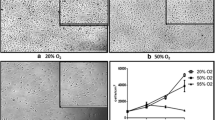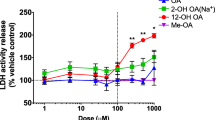Abstract
Methylamine (MA), a component of serum and a metabolite of nicotine and certain insecticides and herbicides, is metabolized by semicarbazide-sensitive amine oxidase (SSAO). MA is toxic to cultured human umbilical vein and calf pulmonary artery endothelial cells. Endothelial cells, which do not exhibit endogenous SSAO activity, are exposed to SSAO circulating in serum. In contrast, vascular smooth muscle cells (VSMC) do exhibit innate SSAO activity both in vivo and in vitro. This property, together with the critical localization of VSMC within the arterial wall, led us to investigate the potential toxicity of MA to VSMC. Cultured rat VSMC were treated with MA (10−5 to 1 M). In some cultures, SSAO was selectively inhibited with semicarbazide or MDL-72145 [(E)-2-(3,4-dimethoxyphenyl)-3-fluoroallylamine]. Cytotoxicity was measured via MTT, vital dye exclusion, and clonogenic assays. MA proved to be toxic to VSMC only at relatively high concentrations (LC50 of 0.1 M). The inhibition of SSAO with semicarbazide or MDL-72145 did not increase MA toxicity, suggesting that the production of formaldehyde via tissue-bound, SSAO-mediated MA metabolism does not play a role in the minimal toxicity observed in isolated rat VSMC. The omission of fetal calf serum (FCS), which contains high SSAO activity, from media similarly showed little effect on cytotoxicity. We conclude that VSMC—in contrast to previous results in endothelial cells—are relatively resistant to MA toxicity, and SSAO does not play a role in VSMC injury by MA.
Similar content being viewed by others
References
Smith, D.J. and Shuster, R.C. (1962). Biochemistry of lathyrism. I. Collagen biosynthesis in normal and lathyritic chick embryos. Arch. Biochem. Biophys. 98:498–501.
Lowis, S., Eastwood, M.A. and Brydon, W.G. (1985). The influence of creatine, lecithin and choline feeding on aliphatic amine production and excretion in the rat. Br. J. Nutr. 54:43–51.
Zeisel, S.H., Wishnok, J.S. and Blusztajn, J.K. (1983). Formation of methylamines from ingested choline and lecithin. J. Pharmacol. Exp. Ther. 225:320–324.
Davis, J.E. and De Ropp, R.S. (1961). Metabolic origin of urinary methylamine in the rat. Nature 190:636–637.
Krishna, J.G. and Casida, J.E. (1966). Fate in rats of the radiocarbon from ten variously labled methyl- and dimethyl-carbamate-insecticide chemicals and their hydrolysis products. J. Agric. Food Chem. 14:98.
Hodge, H.C., Downs, W.L., Panner, B.S., et al. (1967). Oral toxicity and metabolism of Diwron (N-(3,4-dichlorophenyl)-N′,N′-dimethylurea) in rats and dogs. Food Chem. Toxicol. 5:513–531.
Ibe, A., Saito, K., Nakazato, M., et al. (1991). Quantitative determination of amines in wine by liquid chromatography. Ass. Official Anal. Chemists 74(4):695–698.
Yang, G.H., Wang, Y.M. and Chen, L. (1995). Treatment and care of 35 cases of monomethylamine poisoning. Chung-Hua Hu Li Tsa Chih Chinese J. of Nursing. 30(2):83–85.
Callingham, B.A., Crosbie, A.E. and Rous, B.A. (1995). Some aspects of the pathophysiology of, semicarbazidesensitive amine oxidase enzymes, in Progress in Brain Research (Yu, P., Tipton, K.F. and Boulton, A.A., eds.), Elsevier Science, New York, pp. 305–321.
Precious, E. and Lyles, G.A. (1988). Properties of a semicarbazide-sensitive amine oxidase in human umbilical artery. J. Pharm. Pharmacol. 40:627–633.
Hysmith, R.M. and Boor, P.J. (1987). In vitro expression of benzylamine oxidase activity in cultured porcine smooth muscle cells. J Cardiovasc. Pharmacol. 9:668–674.
Lyles, G.A. and Fitzpatrick, C.M.S. (1985). An allylamine derivative (MDL-72145) with potent irreversible inhibitory actions on rat aorta semicarbazide-sensitive amine oxidase. J. Pharm. Pharmac. 37:329–335.
Ryder, T.A., MacKenzi, M.L., Lewinsohn, R., Pryse-Davis, J. and Sandler, M. (1980). Amine oxidase histochemistry of the human uterus during the menstrual cycle. Histochemistry 67:199–204.
Lewinsohn, R. (1981). Amine oxidase in human blood vessels and nonvascular smooth muscle. J. Pharm. Pharmacol. 33:569–575.
Wibo, M., Duong, A.T. and Godfraind, T. (1980). Subcellular localization of semicarbazide-sensitive amine oxidase in rat aorta. Eur. J. Biochem. 112:87–94.
Lyles, G.A. (1996). Mammalian plasma and tissue-bound semicarbazide-sensitive amine oxidases: biochemical, pharmacological and toxicological aspects. Int. J. Biochem. Cell. Biol. 28:259–274.
Baba, S., Watanabe, Y., Gejyo, F. and Arakawa, M. (1984). High-performance liquid chromatographic determination of serum aliphatic amines in chronic renal failure. Clin. Chem. Acta 136:49–56.
Dar, M.S., Morselli, P.L. and Bowman, E.R. (1985). The enzymatic systems involved in the mammalian metabolism of methylamine. Gen. Pharmacol. 16:557–560.
Boor, P.J., Trent, M.B., Lyles, G.A., Tao, M. and Ansari, G.A.S. (1992). Methylamine metabolism to formaldehyde by vascular semicarbazide-sensitive amine oxidase. Toxicology 73:251–258.
Yu, P.H. and Zuo, D. (1993). Oxidative deamination of methylamine by semicarbazide-sensitive amine oxidase leads to cytotoxic damage in endothelial cells. Possible consequences for diabetes. Diabetes 42:594–603.
Yu, P.H. and Zuo, D.M. (1996). Formaldehyde produced endogenously via deamination of methylamine. A potential risk factor for initiation of endothelial injury. Atherosclerosis 120:189–197.
Yu, P.H. and Deng, Y.L. (1998). Endogenous formaldehyde as a potential factor of vulnerability of atherosclerosis: involvement of semicarbazide-sensitive amine oxidase-mediated methylamine turnover. Atherosclerosis 140:357–363.
Lewinsohn, R., Bohm, K.H., Glover, V. and Sandler, M.A. (1978). A benzylamine oxidase distinct from monoamine oxidase B—wide spread distribution in man and rat. Pharmacol. 27:1857–1863.
Bradford, M.M. (1976). A rapid and sensitive method for the quantitation of microgram quantities of protein utilizing the principle of protein-dye binding. Anal. Biochem. 72: 248–254.
DeClerck, Y.A. and Jones, P.A. (1980). The effects of ascorbic acid on the nature and production of collagen and elastin by rat smooth-muscle cells. Biochem. J. 186:217–225.
Jones, P.A., Scott-Burden, T. and Gevers, W. (1979). Glycoprotein, elastin, and collagen secretion by rat smooth muscle cells. Proc. Natl. Acad. Sci. USA 76(1):353–357.
Borenfreund, E., Babich, H. and Martin-Alguacil, N. (1988). Comparisons of two in vitro cytotoxicity assays—the neutral red (NR) and tetrazolium MTT test. Toxicology In Vitro 2:1–6.
Mosmann, T. (1983). Rapid colorimetric assay for cellular growth and survival: application to proliferation and cytotoxicity assays. J. Immunological Meth. 65:55–63.
Freshney, R.I. (1987). Culture of animal cells. A manual of basic technique. 2/e, Wiley-Liss, New York, pp. 253–254.
Boor, P.J. (2001). The arterial media as a target of injury by chemicals in Cardiovascular Toxicology, 3/e, (Acosta D., ed.) Academic Press, Taylor and Francis, London, pp. 557–582.
Conklin, D.J., Langford, S.D. and Boor, P.J. (1998). Contribution of serum and cellular semicarbazide-sensitive amine oxidase to amine metabolism and cardiovascular toxicity. Toxicological Sciences 46:386–392.
Author information
Authors and Affiliations
Corresponding author
Rights and permissions
About this article
Cite this article
Langford, S.D., Trent, M.B. & Boor, P.J. Cultured rat vascular smooth muscle cells are resistant to methylamine toxicity. Cardiovasc Toxicol 1, 51–60 (2001). https://doi.org/10.1385/CT:1:1:51
Issue Date:
DOI: https://doi.org/10.1385/CT:1:1:51




